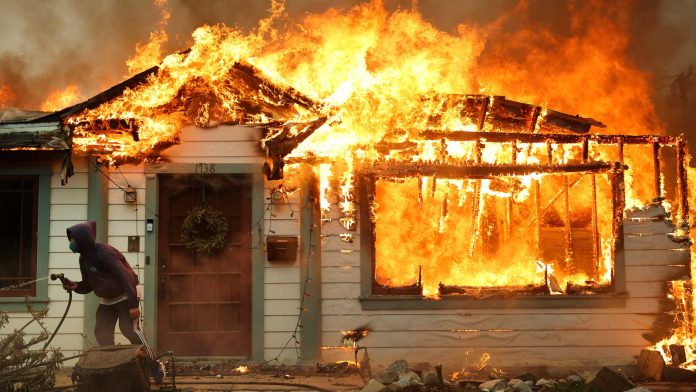Asheville, North Carolina, was once widely considered a climate haven thanks to its elevated, inland location and cooler temperatures than much of the Southeast. Then came the catastrophic floods of Hurricane Helene in September 2024.
It was a stark reminder that nowhere is safe from climate-worsened extreme weather risks: Hurricanes arriving from the Gulf of Mexico and Atlantic seaboard. Hail in the Midwest. Floods in the East. Sea level rise along the coasts. Wildfires in the West, most recently exemplified by the devastating and costly fires around Los Angeles.
And worsening extreme weather translates into more expensive property damages, growing insurance claims, and rising insurance rates. Somebody has to pay for the costs to repair, rebuild, and replace damaged homes and vehicles, but with insurance companies raising rates and dropping customers, the situation is quickly threatening to trigger an insurance crisis.
Despite rapidly rising policy rates, the homeowner’s insurance market lost money in 18 states in 2023. As a recent Senate Budget Committee staff report concluded, climate-worsened extreme weather is “destabilizing insurance markets.”
And the problem extends beyond insurance policy costs.
“If home values fall, governments take in less tax revenue. That means less money for schools and police,” said New York Times climate change reporter Christopher Flavelle on The Daily podcast. “Maybe instead of climate change wrecking communities in the form of a big storm or a wildfire or a flood, maybe even before those things happen, climate change can wreck communities by something as seemingly mundane and even boring as insurance.”
There are no easy solutions to the problem, but there are measures individuals and governments can take to reduce risks and try to avert a widespread insurance crisis.
Insurance rates rising everywhere, especially in areas of high risk
Insurance generally operates by pooling risks. Most property owners buy home and vehicle insurance policies, and from that large pool of customers, insurance companies only have to make payouts to the few who experience costly damages. When climate change increases the frequency and intensity of disasters, insurance companies will spread the costs across the customer pool in the form of higher rates.
So even if you haven’t been directly harmed by extreme weather, you’re paying for some of the costs of those climate-worsened disasters. According to realtor.com, average U.S. home insurance rates rose nearly 34% from 2018 to 2023 – and over 11% in 2023 alone.
Some of those higher prices are related to rising inflation because repairing damaged homes has become more costly. But both home and auto insurance rates have consistently risen much faster than the rate of inflation over the past 15 years.

That’s in large part due to climate change. As one example, scientists estimated that climate change made Hurricane Helene twice as destructive and increased its rainfall by over 50% in some areas. Auto data company CARFAX estimated that the storm left…afe insurance coverage.
And they’re often partially funded by private insurance companies, meaning that they can shift costs to the rest of the pool of insurance customers. As a result, residents across California could see higher home insurance premiums when the state’s FAIR program runs out of money and draws from private insurers to fund payouts to the wildfire-impacted homes around Los Angeles.
Some states like California also tightly regulate insurance rates. That can help keep costs down for consumers in those states, but it also shifts the problem of rising costs elsewhere and forces insurers to drop customers in high-risk areas or leave the state altogether (as a result, California…).
A recent paper by three economists found that insurers also compensate for this effect by raising rates in less-regulated states like Oklahoma, distorting insurance prices. The authors concluded that if insurance in all states were equally regulated, rates would have grown 20 percentage points faster in high-risk states relative to other states.
These kinds of distortions have contributed to large influxes of Americans migrating to high-risk locations like Florida and regions of California facing significant wildfire risks because insurance policy prices aren’t accurately reflecting those dangers.
Options for averting an insurance crisis
One partial solution to the problem involves the opposite behavior – encouraging managed retreats from high-risk areas. This is a challenging and complex topic because people tend to have strong attachments to their homes. But when a house is badly damaged by extreme weather and faces a high risk of a repeat event in the future, tying insurance payouts to a move to a safer area is one possible solution. It’s one that the Canadian province of Quebec employed after destructive flood events along the Ottawa River in 2017 and 2019. Other regulatory and market-based tools can help discourage new property developments in high-risk areas.
Homeowners can also implement measures to reduce their risks, for example by clearing brush around homes in wildfire-prone areas or installing metal roofs in regions susceptible to worsening hailstorms. Insurers and governments rarely pay for these efforts, but that’s beginning to change as the importance of hardening homes against extreme weather risks becomes more widely recognized. Hurricane- and tornado-battered Alabama is leading the way in this approach.
To mitigate wildfire risks in areas like California, governments can take steps to reduce the density of dry vegetation. These include prescribed burns – intentionally igniting a controlled fire to burn flammable material. But that practice can be difficult and dangerous in areas with housing, where goat herds can instead be brought in to consume that vegetation.





